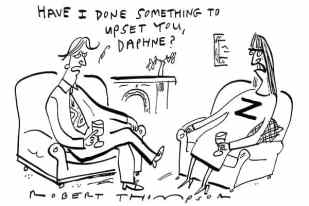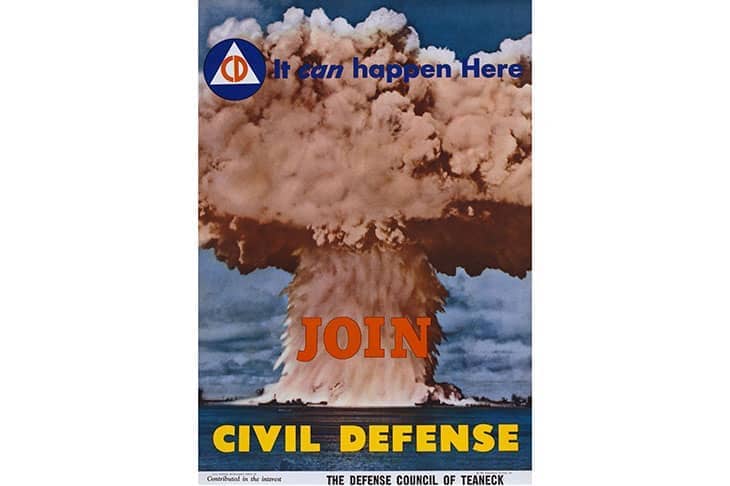Having just dusted down my Geiger counter and argued with the family about whether or not there is room for our dog, Jessie, in the cellar fallout shelter, I thought I would check in with the Bulletin of the Atomic Scientists to see how long we’ve got before our recently acquired small paddock sprouts its first crop of Cobalt-60.
The Bulletin of the Atomic Scientists was begun in 1945 by the physicists who, having devoted several years of their lives to the Manhattan Project, suddenly realised that their striving might not be, in the end, exclusively beneficial for the human race. As the most lionised of them, J. Robert Oppenheimer, put it at the time (without a great deal of cheer): ‘Now I am become death, destroyer of worlds.’
Concerned, then, that their babies would proliferate and eventually curtail the existence of the human race, the most senior nuke specialists created this bulletin to report, every year, on how close to annihilation we were. So, for example, during the early height of the Cold War in 1953, just after the USA’s ‘Ivy Mike’ nuclear test (the first ever thermonuclear explosion which, briefly, created every element known to mankind and invented several new ones too), the hands of the Doomsday Clock were placed at two minutes to midnight. Fair enough, you might suppose; it was an awfully fraught period.

The Doomsday Clock remained, for the next 30 or so years, a baleful and very media-friendly indicator of our yearning for extinction. The problem is that in later years it became both politicised and Thunbergised. With nuclear conflagration off the menu for most of the 1990s, the scientists needed a new existential ogre to chill us with, and of course climate change provided them precisely with that.
If you look at the Science and Security Board of the BOAS, there are plenty of people for whom the word ‘quark’ would likely conjure up not a bunch of important sub-atomic particles – up, down and what have you – but a rather insipid form of soft cheese. There are marketing monkeys, lawyers and plenty of alumni from the environmental studies departments of European and US universities. Global warming has taken over from nuclear conflagration as the threat to our existence.
Further, the left liberals have the Bulletin in their grip (the former Democrat governor Jerry Brown is the executive chairman, or ‘chair’ as he prefers to call it), which is why the hands of the Doomsday Clock are now perpetually a minute or so away from midnight. The liberal left is always shrill and always absolutist and it can never believe that things might get better, or have not become worse. So in 2019 the hands of the Doomsday Clock were on two minutes to midnight, the same as they were in 1953. Why? Was the threat to our existence really that acute three years ago? What worried them then was that the USA was led by a man with whom they disagreed, Donald Trump. A year later Covid had knocked another 20 seconds off our remaining time alive, leaving us scarcely enough breathing space to recite a few Hail Marys.
Global warming has taken over from nuclear conflagration as the threat to our existence
Oddly, although the hands remained in the same place in 2021, the report was a little cheerier because of course Donald Trump had departed the scene. The inference we were supposed to draw was that mighty Joe Biden was a better bet to preserve both world peace and the polar bears than was Trump. Ha! But by contrast, during the Cuban Missile Crisis the hands of that clock were at eight minutes to midnight. Were we really closer to annihilation in 2019 than 1962?
By now, I thought, with Vladimir Putin threatening nuclear war every time he or his Addams Family foreign affairs spokesman Sergei Lavrov opens his mouth, it must be about a quarter past 12. But no, the latest bulletin still has us at 100 seconds to midnight: the genuine threat of nuclear warfare – which must be at least around the 2 to 3 per cent mark – bothers them far less than the equivocations at COP26.
Meanwhile, I have my doubts. We are being borne aloft at the moment on a tide of emotive propaganda emanating from Kiev, for which I do not remotely blame the Ukrainians (who are the unequivocal victims in this, despite whatever the deranged legion of British Putin fellow-travellers insist). My wish is that we would be a little less credulous, while continuing to cheer in an excited manner from the sidelines as if we were watching an FA Cup tie between, say, Manchester City and Dover Athletic. A lot of the stuff that makes the front pages of the newspapers later seems to dissolve a little under scrutiny. As I say, I do not blame the Ukrainians for using every trick in the book to advance their case among the western Europeans, glued to their TVs. What I want to know is not the precise details – just the gist.
The Ukrainians say they have killed 12,000 Russian troops. Does that sound credible? Is it more or less credible than the Russian assertions that only a few hundred have been killed? Did Putin really not expect either the Ukrainians to fight with such vigour, or the rest of the developed world to impose the sort of sanctions on his benighted country that we are now seeing? I’m not sure I buy that. Putin is ruthless and in many senses a quintessential fascist, but he is some distance from being thick. Is the Russian advance really as bogged down – or is it progressing, with difficulty, in exactly the manner Putin expected?
It is here, in these grey areas, that we crave a little certainty and truth, so that we can better assess the likelihood of the entirety of western Europe becoming a very grey area indeed. But then as the cliché has it, truth is the first casualty of warfare.







Comments